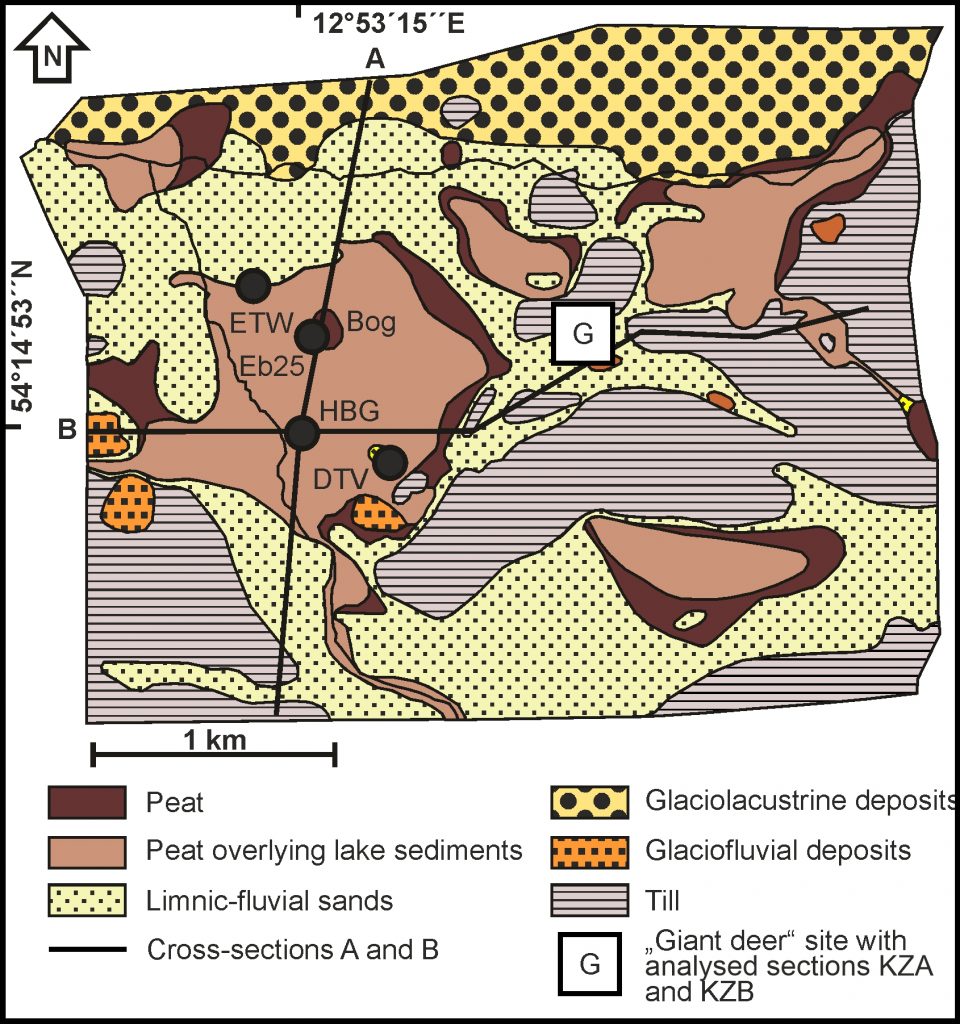Alder carr development in NE Germany
Actuo-ecological studies in alder carrs have indicated a considerable natural dynamic in carr development, in which forested phases alternate with phases of open wetland vegetation. Palaeoecological studies were started in NE Germany in order to investigate whether such alternating phases can also be traced in the past.

Cyclic vegetation development in alder carrs (after Stegner, 2000, based on actuo-ecological observations in eastern Germany). Lower part: groundwater level (solid line) relative to surface (dashed line). A: Alder carr stand with specimens of similar age, herbaceous vegetation mainly Carex elongata; B: incidental intensive flooding event that damages alder; C: Dying alder trees with – as consequence of decreased evapotranspiration – increased groundwater level; herbaceous vegetation with mainly Glyceria fluitans and Phragmites; D: collaps of dead alder trees and a consequent increase in available light, establishment of mainly Carex paniculata; E: development of a hummock-hollow complex; F: establishment of young alder (or Salix cinerea as intermediate stage) on the Carex hummocks, slowly increasing evapotranspiration and consequent decrease of groundwater levels; G: development of an alder carr vegetation, with Carex elongata in the herbaceous layer, gradual levelling of groundwater levels.
Endinger Bruch
The Early and Middle Holocene wetland development of the Endinger Bruch (Vorpommern, NE Germany) was reconstructed from analysis of pollen, macrofossils, and non-pollen palynomoprhs of core HBG from central part of the area. After a lake phase, an alder carr developed. Four phases with a more or less closed carr alternated with three phases of an open herbaceous wetland vegetation, which were probably restricted to the surroundings of the core location and did not necessarily occur in the complete area. These phases lasted several centuries and, thus, exceded short-lived cyclic development of alder carrs as inferred from actuo-ecological studies (although there are also indications for such shorter phases). Alder tree dying was probably caused by a dryland forest decline that induced a long-term water level rise in the fen. Alder re-established itself when sufficient drier spots were available on newly formed hummocks, after sufficient peat formation had caused the mire surface to rise above the water level, or after a general decline of water levels.

Geomorphological map of the Endinger Bruch area with location of core HBG
Rodder Forst
Another study area is the Rodder Forst in Vorpommern, where next to analyses of a complete core, high-resolution analyses were carried out to study single phases in alder carr development. These provide information on short-lived vegetation dynamics. During the total studied time-span of ca. 800 years, two phases of alder carrs with a duration of ca. 100 and 150 years alternated with phases of open herbaceous vegetation and phases of willow shrubs. The long interval between both carr phases of around 400 years illustrates the difficulties for alder to re-establish itself.
This study is related to the ALNUS project and is carried out in close cooperation with Alexandra Barthelmes.
Publications:
Barthelmes, A. (2002): Vom Kesselmoor zum Quellmoor – ungewöhnliche Moorbildungssequenzen im Rodder Forst (Mecklenburg-Vorpommern). Greifswalder Geographische Arbeiten 26: 131-134.
Barthelmes, A., Prager, A. & Joosten, H. (2006): Palaeoecological analysis of Alnus wood peats with special attention to non-pollen palynomorphs. Review of Palaeobotany and Palynology 141: 33-51.
Barthelmes, A., de Klerk, P., Prager, A., Theuerkauf, M., Unterseher, M. & Joosten, H. (2012): Expanding NPP analysis to eutrophic and forested sites: significance of NPPs in a Holocene wood peat section (NE Germany). Review of Palaeobotany and Palynology 186: 22-37.
Barthelmes, A., Gerloff, D., de Klerk, P. & Joosten, H. (2010): Short-term vegetation dynamics of Alnus dominated peatlands: a high resolution palaeoecological case study from western Pomerania. Folia Geobotanica 45: 279-302.
De Klerk, P.: (2017): Contributions to the European Pollen Database 31: Endinger Bruch Hoher Birkengraben (NE Germany): from lake to carr. Grana 56: 155-157.
Related publication:
Stegner, J. (2000): Erlenbruchwälder – Dynamik in Raum und Zeit. Naturschutz und Landschaftsplanung 32: 261-270.
Your e-mail address will not be published.